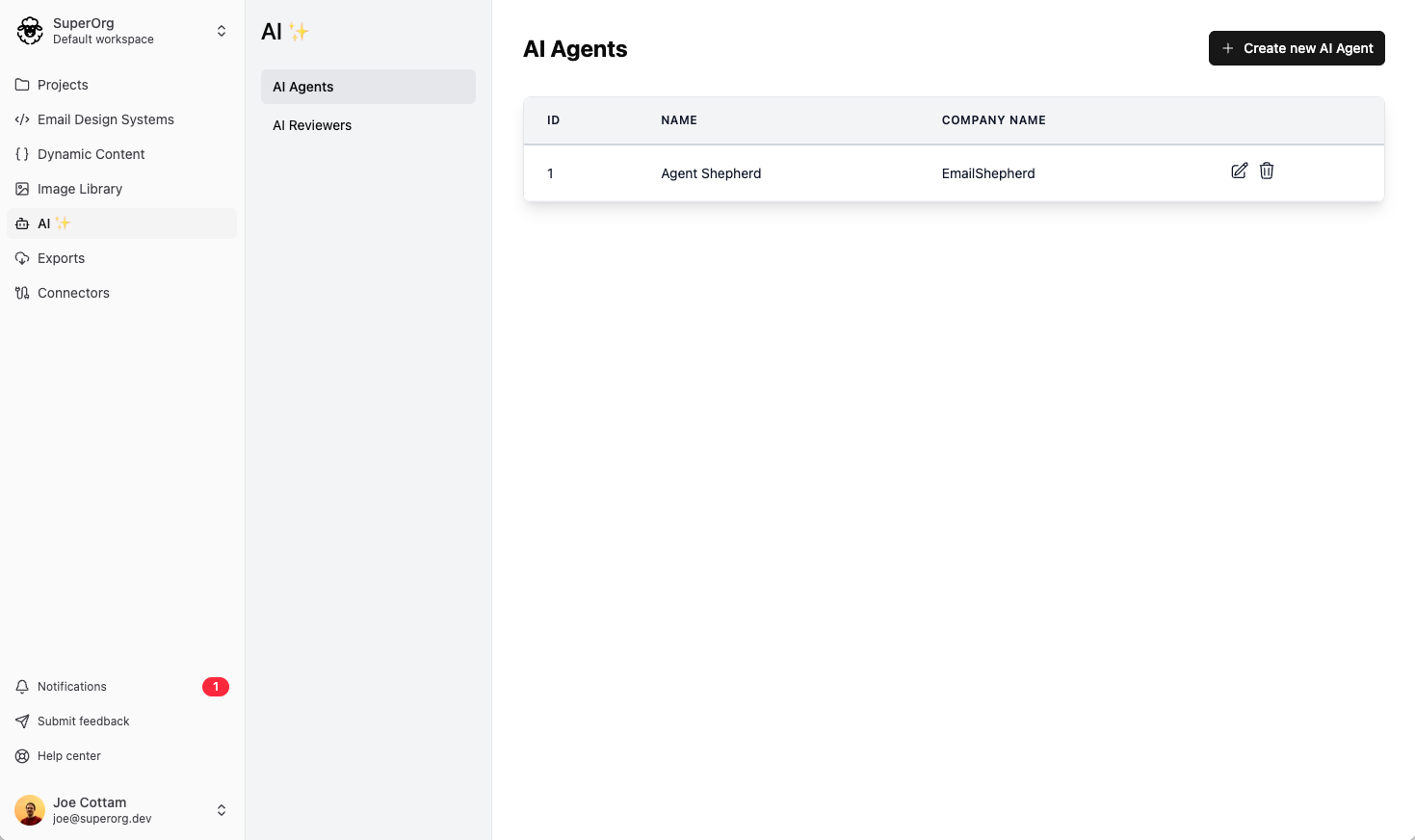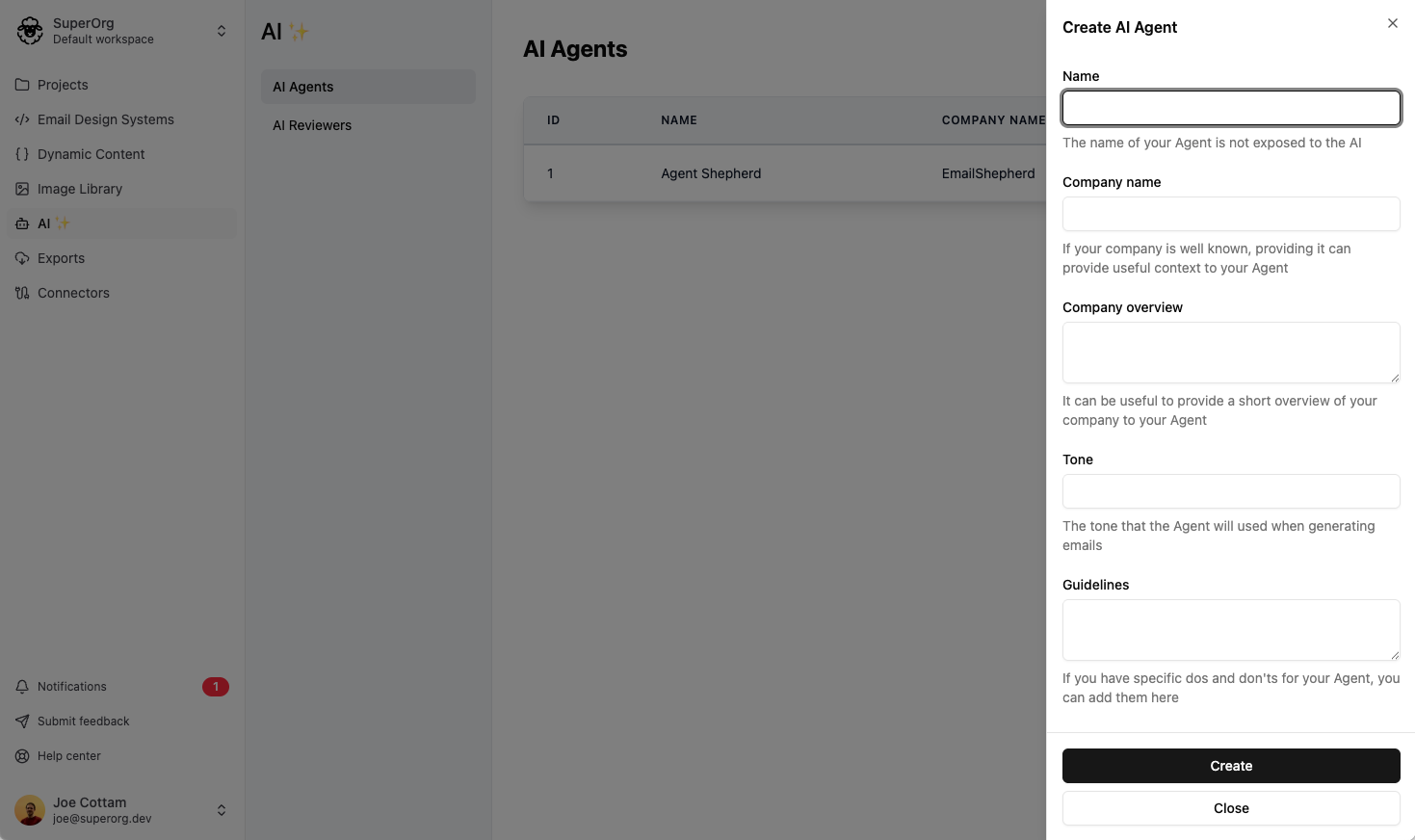AI Agents
AI Agents in EmailShepherd are responsible for generating emails, and email content, using AI. Each agent is configured with your specific brand voice, guidelines, and context, ensuring that generated emails stay consistent with your messaging and tone.
Why Use AI Agents?
AI Agents effectively let you set up a lot of important contextual prompt information for the AI once, which improves the output and also saves you time rather than having to repeat the same information every time you prompt the AI.
Creating an AI Agent
To create an AI Agent, navigate to the AI page in the sidebar and select the AI Agents tab.

Click the Create new AI Agent button to get started.

Configuration Fields
When creating your AI Agent, you'll configure several fields that shape how it generates content:
Name
Give your agent a descriptive name that reflects its purpose.
- Examples: "Marketing Emails", "Executive Communications", "Product Updates"
Company Name (optional)
Your company, organization, or team name. If your company is well-known, this provides helpful context for the AI to understand your industry and audience.
Company Overview (optional)
A brief description of your company, department, or product. This helps the AI understand your business context and generate more relevant content.
Examples:
- "B2B SaaS platform helping marketing teams create better email campaigns"
- "E-commerce retailer specializing in sustainable outdoor gear"
- "Internal IT team supporting 500+ employees across 3 offices"
Tone (optional)
Describe the voice and personality you want in your emails. This affects word choice, sentence structure, and overall feel.
Examples:
- "Professional but approachable, helpful without being pushy"
- "Casual and friendly, like talking to a colleague"
- "Authoritative and informative, suitable for executive updates"
- "Enthusiastic and energetic, perfect for product launches"
Guidelines (optional)
Specific instructions and rules you want the AI to follow. This is like adding permanent instructions that apply to every email this agent creates.
Useful guidelines might include:
- "Always include a clear call-to-action in marketing emails"
- "Keep emails under 200 words for mobile readability"
- "Never mention competitor products directly"
- "Include an unsubscribe reminder in promotional emails"
- "Use 'we' instead of 'I' when speaking for the company"
- "Always end support emails with 'Let me know if you need anything else'"
Brand Guidelines Document (optional)
Upload your existing brand guidelines document to give the AI comprehensive understanding of your brand standards, voice, and messaging rules. If you upload a brand guidelines document, the tone and guidelines fields will be ignored in favor of the information in the document.
Creating Multiple Agents
In practice, may want multiple agents for different communication types. Each agent can have distinct personality and guidelines while sharing your overall brand foundation.
Example agent setup:
"Marketing Campaigns" Agent:
- Tone: "Enthusiastic and benefit-focused, emphasizing value for customers"
- Guidelines: "Always include social proof when available, focus on customer benefits over features, include urgency when appropriate"
"Internal Updates" Agent:
- Tone: "Direct and informative, appropriate for team communications"
- Guidelines: "Use bullet points for action items, include relevant deadlines, keep updates concise"
Using Your Configured Agent
Once created, your AI agent will use this configuration every time you chat with it in the email editor. You won't need to repeat your brand guidelines or tone preferences - the agent already knows how you want to communicate.
This means you can focus your prompts on the specific content: "Create a product launch email for our new analytics feature" instead of "Create a professional but friendly product launch email that follows our brand guidelines and includes a clear call-to-action..."
Best Practices
Start simple: Begin with basic tone and guidelines, then refine based on the outputs you get
Be specific in guidelines: Instead of "be professional," try "use formal language but avoid jargon"
Test with different requests: Try various email types to see how well your agent captures your brand voice
Iterate and improve: Update your agent configuration as you learn what works best for your needs